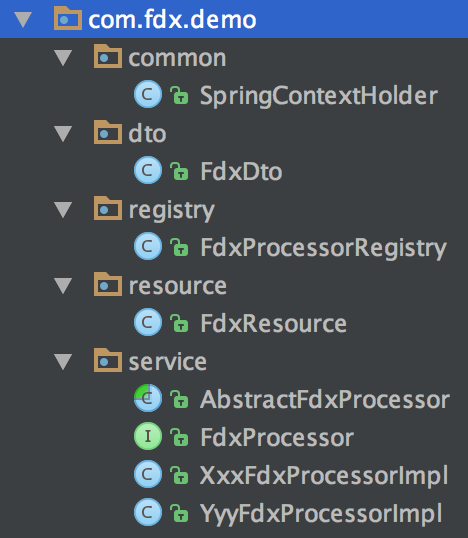缘起
在业务团队写代码,经常会遇到这种情况,产品经理来个需求,好的,我们加个字段,加个if else. 谢晞鸣最近总结了一些比 if else 优雅一点的套路,能够让自己代码的逼格看起来稍微高点。很多时候分支是不可避免的,不同的业务,肯定要走不同的分支,我这里所谓的优雅套路,本质上就是用一个 Map 将 “条件” 和 ”业务处理逻辑“ 两者映射起来。
这里假设我们的项目是基于Spring的。文章中列的代码是不完整的,说明意思即可。
if else
有这样一种业务场景,我们做保险产品项目,不同产品核保的逻辑是不一样的(对年龄、限额、职业、性别等等的要求都不一样),假设有两个字段, productCategory, productSubCategory 用于区分不同类型的保险(万能险、投连险、养老险、产险等)。我们可以这么写1
2
3
4
5if (productCategory.equals("XXX")){
processXXX();
} else if(productCategory.equals("YYY")){
processYYY();
}
优雅的套路
我们也可以设计这样一个结构来处理这种业务,将我们的 ”条件”(即产品类型) 和 “业务处理逻辑”(即核保逻辑) 映射起来, 下面是一个很简单的 demo:,源码地址

先来介绍各个package:
- resource, 项目入口层,可以理解成我们常见的controller、facade 之类的层
- service, 业务逻辑层
- registry, 我们的注册中心,负责业务逻辑的路由
- dto, 接口调用传递的数据对象
- common, 一些公共组件
后面的介绍中删减了get/set方法,先看service层1
2
3public interface FdxProcessor {
void process(FdxDto<?> fdxDto);
}
1 | public class FdxDto<T> { |
面向接口编程,每种类型的产品的处理逻辑都必须实现该接口,这里的 DTO 是一个泛型,为了支持各种类型的数据,也定义了一些必传的参数,比如这里的两个category.接下来是一个关键的抽象类,这里完成了业务逻辑的注册。
1 | public abstract class AbstractFdxProcessor implements FdxProcessor, InitializingBean, BeanNameAware { |
- 实现业务接口FdxProcessor
- 实现 BeanNameAware 接口,为了获得每个processor 在 Spring context 中的 beanName
- 实现 InitializingBean 接口(这是 Spring 提供的一些生命周期接口中的一个),在 Spring 完成该Bean初始化之后,将 beanName 注册到注册中心去
- 注意抽象方法 getKeyPair, 这是子类必须实现的,用于构造注册时用的key,即之前说的 “条件”。关于这个 “条件”,有多种实现方式,后面再细聊。
然后就是每种产品具体的业务逻辑实现:1
2
3
4
5
6
7
8
9
10
11
12
13
14
15
16
17
18
19
20
21
22
23
24
25
26
27
28
29
30
31/**
* XXX 产品的业务逻辑
*/
public class XxxFdxProcessorImpl extends AbstractFdxProcessor{
public void process(FdxDto<?> fdxDto) {
//do business
}
protected FdxProcessorRegistry.FdxKeyPair getKeyPair() {
return new FdxProcessorRegistry.FdxKeyPair("XXX","XXX");
}
}
/**
* YYY 产品的业务逻辑
*/
public class YyyFdxProcessorImpl extends AbstractFdxProcessor {
public void process(FdxDto<?> fdxDto) {
//do business
}
protected FdxProcessorRegistry.FdxKeyPair getKeyPair() {
return new FdxProcessorRegistry.FdxKeyPair("YYY", "YYY");
}
}
接下来看下这个简单的注册中心,主要实现了
- 注册,将 key 和 beanName 映射起来
- 获取,通过 key 获得 beanName,然后通过 beanName 从 Spring Context 中获得真正的 bean
1
2
3
4
5
6
7
8
9
10
11
12
13
14
15
16
17
18
19
20
21
22
23
24
25
26
27
28
29
30
31
32
33
34
public class FdxProcessorRegistry {
private Map<FdxKeyPair, String> config = new HashMap<FdxKeyPair, String>();
public void put(FdxKeyPair key, String beanName) {
config.put(key, beanName);
}
public FdxProcessor get(FdxKeyPair key) {
return SpringContextHolder.getBean(config.get(key));
}
public static class FdxKeyPair {
private String productCategory;
private String productSubCategory;
public FdxKeyPair(String productCategory, String productSubCategory) {
this.productCategory = productCategory;
this.productSubCategory = productSubCategory;
}
public int hashCode() {
//TODO
return 1;
}
public boolean equals(Object obj) {
//TODO
return true;
}
}
}
入口层这样使用的就可以了.1
2
3public void doFdx(FdxDto fdxDto) {
fdxProcessorRegistry.get(new FdxKeyPair(fdxDto.getProductCategory(), fdxDto.getProductSubCategory())).process(fdxDto);
}
套路的变种
最后,关于 “条件” 和 “业务逻辑” 之间的映射,可能会有这样一些其他的实现方式,
1. 用于路由的条件比较简单
比如说只有一个category, 我们可以定义一个 annotation,比如1
2
3
4
5
6(RetentionPolicy.RUNTIME)
(ElementType.TYPE)
public FdxCategory {
String productCategory() default {};
}
将它用在XxxFdxProcessorImpl这些子类上,然后稍微修改一下AbstractFdxProcessor1
2
3
4
5
6
7
8
9
10
11public abstract class AbstractFdxProcessor implements FdxProcessor, BeanPostProcessor{
private FdxProcessorRegistry fdxProcessorRegistry;
public Object postProcessAfterInitialization(Object bean, String beanName) throws BeansException {
FdxCategory fdxCategory = bean.getClass().getAnnotation(FdxCategory.class);
//通过 fdxCategory 拿到 category, 作为 key 和 beanName 一起进入注册中心完成注册
}
return bean;
}
}
2. 用于路由的条件比较复杂
可以自定义 Key 类,但是要注意重写好 equals 和 hashCode
3. 每套逻辑可能适用于多个category
这种情况可以将一些公共的逻辑抽象出来放在抽象类中,也可以在 “条件” 上做些文章,比如可以这么搞:1
2
3
4
5
6
7
8
9
10
11
12
13
14
15
16
17
18
19
20
21
22
23
24
25
26
27
28
29
30
public class XyzFdxProcessorImpl extends AbstractFdxProcessor {
protected List<FdxKeyPair> getKeyPair() {
List<FdxKeyPair> list = new LinkedList<FdxKeyPair>();
list.add (new FdxKeyPair("XXX", "XXX"));
list.add (new FdxKeyPair("YYY", "YYY"));
list.add (new FdxKeyPair("ZZZ", "ZZZ"));
return list;
}
}
public abstract class AbstractFdxProcessor implements FdxProcessor, InitializingBean, BeanNameAware {
private FdxProcessorRegistry fdxProcessorRegistry;
protected String beanName;
public void setBeanName(String name) {
beanName = name;
}
protected abstract List<FdxKeyPair> getKeyPair();
public void afterPropertiesSet() throws Exception {
List<FdxKeyPair> fdxKeyPairs = getKeyPair();
for(FdxKeyPair fdxKeyPair : fdxKeyPairs){
fdxProcessorRegistry.put(fdxKeyPair, beanName);
}
}
}
最后
这种优雅的套路,就是将显示的if else 转换成一个 通过 注册中心 路由的结构。注册中心维护 “条件” 和 “业务逻辑” 的映射,在注册的过程中充分利用了Spring提供的一些生命周期接口。
当然还有其他的一些变种,看具体情况而定,比如一些小的分支,我们可以路由到方法级别,而不是上面bean级别。实现上可以通过在方法上打annotation,然后通过反射的机制去调用。具体不细说了,有兴趣可以通过博客上留的联系方式和我交流。尼玛,说的好像有人看一下,我就是纯粹记笔记。